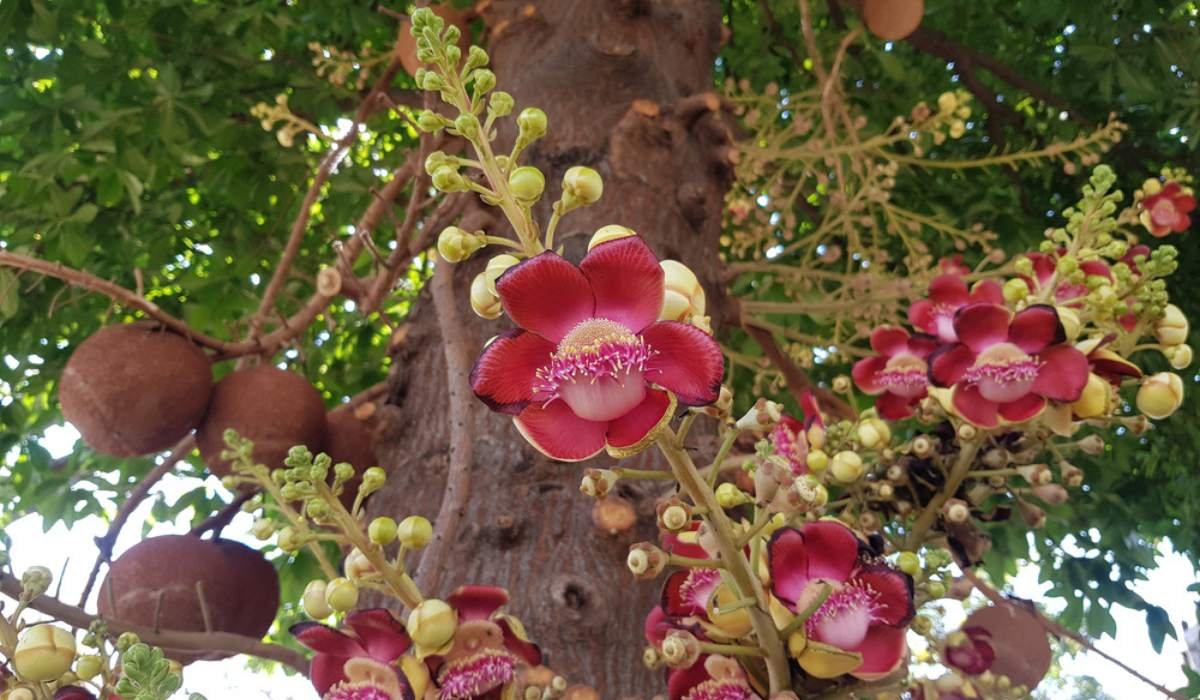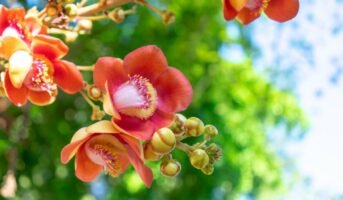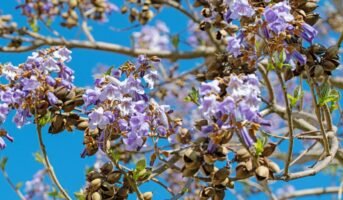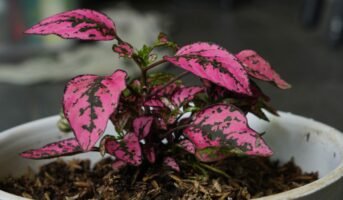A member of the Lecythidaceae family of deciduous trees, Cannonball tree also goes by the names Ayauma tree and sal tree. Its botanical name is Couroupita Guianensis. It produces edible fruit. South and Central American jungles are home to the Cannonball tree. It’s common to find these trees in tropical regions like Thailand, India, Colombia, Bolivia, Costa Rica, Honduras, the United States, Panama, Peru, Ecuador, and Venezuela.
It is grown as a decorative tree in parks and alongside roads. The single cannonball tree produces more than 1,000 fragrant blooms and over 150 fruits annually, mainly in the morning and evening. Bees and bats are both involved in the pollination process. The insects that visit the flowers are wasps, bumblebees, flower bees, and carpenter bees.
know about: Gular tree
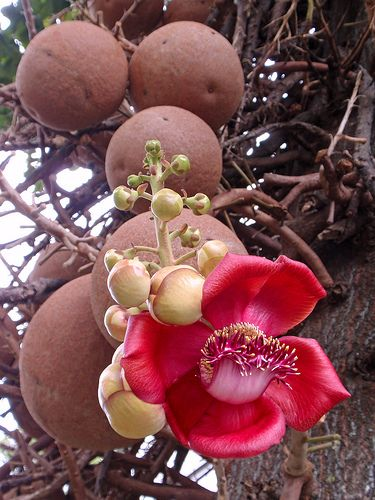
Source: Pinterest
See also: Paulownia Tomentosa: Tree uses, benefits, and care tips
Cannonball tree: Key facts
| Botanical name | Couroupita Guianensis |
| Family Name | Lecythidaceae |
| Native area | Rainforests of South and Central America |
| Environmental impact | Positive |
| Maintenance | High |
| Diameter of fruit | 12-25 cm |
| Taste | Earthy and bitter |
see also: Date tree: How to grow and care for the Khajur tree
Cannonball tree: How to grow?
The Cannonball tree (Couroupita Guianensis) is a tropical tree native to the Amazon rainforest in South America. It is known for its large, round fruits that resemble cannonballs, hence its common name. To grow a cannonball tree, follow these steps:
- Choose a location: A cannonball tree requires a warm, humid environment and prefers full sun to partial shade. It is not frost-tolerant, so it should be grown where temperatures do not drop below freezing.
- Prepare the soil: Cannonball tree grows best in well-draining soil with a pH of 6.0 to 7.0. If your soil is not suitable, you can prepare a mixture of equal parts compost, peat moss, and perlite or sand.
- Plant the tree: Cannonball trees can be propagated by seed or by planting a small tree. If you are planting a small tree, dig a hole twice as wide as the root ball and as deep as the root ball. Place the tree in the hole and fill it with soil, making sure to tamp it down firmly to eliminate air pockets. Water the tree thoroughly after planting.
- Water and fertilise: Cannonball trees require regular watering, especially during the first few months after planting. Water the tree deeply once a week or more frequently if the soil becomes dry. Fertilise the tree with a balanced fertiliser once a month during the growing season.
By following these steps, you can successfully grow a Cannonball tree in your garden.

Source: Pinterest
Cannonball tree: Care tips
For maintaining a Cannonball tree (Couroupita guianensis) in your garden, follow these tips:
- Water regularly: A cannonball tree requires regular watering, especially during the first few months after planting. Water the tree deeply once a week or more frequently if the soil becomes dry.
- Fertilise: Fertilise the tree with a balanced fertiliser once a month during the growing season.
- Prune and shape: Cannonball trees can grow quite large, so it is important to prune and shape the tree to control its size. Prune off any broken or damaged branches, and remove any suckers that appear at the base of the tree.
- Protect from frost: Cannonball trees are not frost-tolerant, so it is important to protect them from freezing temperatures. If you live in an area with frost, you may need to bring the tree indoors or cover it with a protective blanket during the winter.
- Pest control: The cannonball tree is generally resistant to pests and diseases, but it can be susceptible to scale insects and mealybugs. If you notice any pests on your tree, use an organic pest control method to remove them.
By following these care tips, you can keep your Cannonball tree healthy and thriving.
Cannonball tree: Flowering season
The flowers of the Cannonball tree are lovely. The intense and enticing scent of the enormous rose-pink blossoms is strongest in the mornings.
Each one only lasts for one day and has six spreading petals surrounding both fertile and sterile stamens. The fruits that give the Cannonball tree its name are produced by the pollinated blooms. The fruits develop on the vines as well.
Over the course of 18 months, they grow into enormous, spherical balls about the size of cannonballs. On windy days, the fruits, which are woody and reddish brown, bang against one another and make a cannonade-like sound.
When the fruit is ready, it explodes when it hits the ground after falling from the tree. The many seeds inside the fruit can occasionally be seen when the fruit cracks apart.
Cannonball tree: Uses
- Colds and stomach aches are treated with Cannonball tree extracts.
- Skin conditions are treated using the juice collected from the leaves.
- The Shamans of South America utilised tree pieces to cure malaria.
- The pulp of Cannonball trees is applied to wounds to clean them.
- To relieve toothaches, young leaves are employed.
- The extracts from the Cannonball tree are used to treat inflammation, cancer, hypertension, and discomfort.
- To treat skin conditions, juice extracted from its leaves is employed.
- Fruit juice is an expectorant in Ayurveda to treat bronchitis and persistent cough.
- The blossoms have a pleasant aroma that might be used in cosmetics and perfumes.
- Fruits have hard shells that may be used as containers or utensils.
- Boxes, toys, rackets, parquet blocks, light artefacts, and casting moulds are all made from the tree’s wood.
- Hindus in India revere the cannonball tree as a sacred tree.
- The antibacterial characteristics of Cannonball tree extracts make them efficient against E. coli, Staphylococcus, and Bacillus. Fruit extracts have antibacterial properties as well.

Source: Pinterest
Cannonball tree: Toxicity
Cannonball trees are not poisonous to humans, but the fruit and seeds are toxic to animals. The fruits contain a substance called coroutine, which can cause vomiting and diarrhoea if ingested. So, it’s advisable to keep these trees out of pets’ reach.
FAQs
What is a Cannonball tree used for?
Cannonball trees have several traditional uses. In South America, the tree is used to make traditional medicine, and the flowers and leaves are used in religious ceremonies. The tree is also grown for its ornamental value due to its large, showy flowers and fruits.
How big does the Cannonball tree get?
Cannonball trees can grow up to 50 feet tall. It has a fast growth rate and can grow up to 3 feet per year.
Housing News Desk is the news desk of leading online real estate portal, Housing.com. Housing News Desk focuses on a variety of topics such as real estate laws, taxes, current news, property trends, home loans, rentals, décor, green homes, home improvement, etc. The main objective of the news desk, is to cover the real estate sector from the perspective of providing information that is useful to the end-user.
Facebook: https://www.facebook.com/housing.com/
Twitter: https://twitter.com/Housing
Email: [email protected]
